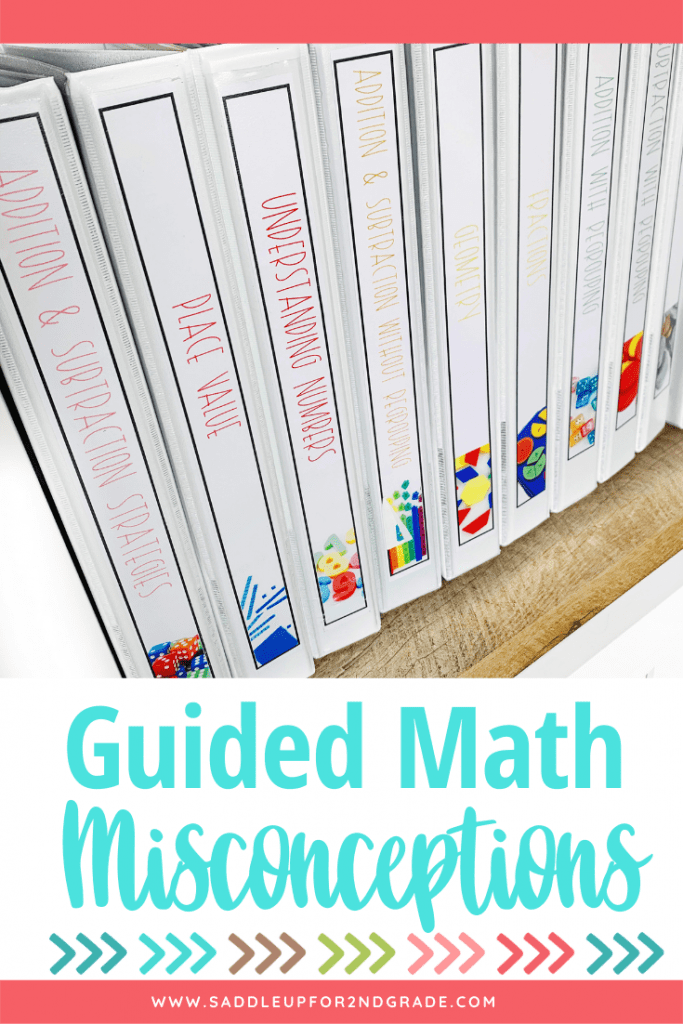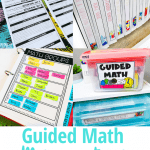

Join me for a FREE, Guided Math workshop to discover how to easily incorporate Guided Math into your current schedule!
When I first shifted my focus to guided math instruction, I learned there are a lot of guided math misconceptions out there.
Once I truly understood the meaning behind what guided math is and what it is not, my approach to teaching math changed for the better. I began to see student success and confidence grow in ways that I had never seen with traditional math instruction.
I want to address some of those common guided math misconceptions today. My hope is this will help you get a clear understanding of this framework, so let’s dive in.

This is by far the most common guided math misconception that I hear. People tell me ALL THE TIME that they don’t have time to learn a new curriculum.
Allow me to set the record straight. Guided math is not a curriculum. Guided math is a framework for how you structure and run your math block WITH your curriculum. Therefore, guided math can be done with ANY curriculum.
It focuses on a gradual release method where learning primarily moves from teacher-led to student-led lessons and activities.
You can read more about this in my How to Use Guided Math With Any Curriculum blog post.
Guided math is not about putting students in math stations to teach the same lesson over and over again to different groups.
Don’t get me wrong, exploring mathematical concepts in math stations is important. This is definitely a component of the guided math framework.
Students need that extra time to practice the skills being taught in a hands-on way. This helps them gain independence and dive deeper into concepts.
However, there is a strategic way that math stations are used within the guided math framework. This ensures all students are working at their instructional level.
This guided math misconception is only partly true. You can start using guided math instruction anytime you want.
However, you have to train your students with the proper routines and procedures. These will help them be successful with guided math first.
You cannot expect students to just know what to do automatically. They must be taught how to transition, how to use math stations, what on-task behavior during independent work looks like, etc.
If you are wanting to start implementing guided math in your classroom, but are unsure where to start, I would highly recommend you check out Managing Math Stations.
This online, self-paced professional development training walks you through step-by-step how to implement guided math into your day. It gives you a step-by-step process for setting up your math block for success, teaching routines and procedures, and much more.

Does guided math consist of mini-lessons? Yes, but that is only one part of all the components. You also want to have some time blocked out in your schedule for independent practice.
This allows you to check for student understanding. Your students might complete a workbook page, do an interactive notebook activity, or play a partner game. All of these have the goal of students being able to show what they know during independent practice.
So what’s the misconception, then?
The key component to guided math is small group instruction. This is where you teach your targeted lessons about a concept towards students’ specific needs.
Like I mentioned above with mini-lessons, math stations are only one component of the guided math framework.
While math stations are great and I’m a big fan of them, they must be utilized correctly in order to be beneficial.
Your math stations need to be:
You can learn more about how to use quality math stations in your classroom in my Math Station Examples blog post.
Now that I’ve broken down some common misconceptions about guided Math, let’s talk about what Guided Math is.

Guided math is a framework for teaching math that focuses on a gradual release method from teacher-led instruction to student-led instruction. This allows teachers to differentiate instruction to meet the needs of all students at all levels.
There are five main components to guided math:
If you’d like to dive deeper into what is included in each component, you can read more in my All About Guided Math blog post.
I hope this blog post was helpful and cleared up some of the questions and misconceptions you may have about guided math.
Feel free to pin the image below to save this post for later and share it with a friend!

Math should be fun, not stressful. Ditch the timed math fact tests and replace them with math games that will help your students learn and retain information more effectively.
© Saddle Up for 2nd Grade • Website by KristenDoyle.co
